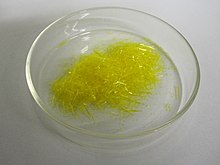| |||

| |||
| Names | |||
|---|---|---|---|
| Preferred IUPAC name
Cyclohexa-2,5-diene-1,4-dione[1] | |||
| Other names | |||
| Identifiers | |||
3D model (JSmol)
|
|||
| 3DMet | |||
| 773967 | |||
| ChEBI | |||
| ChEMBL | |||
| ChemSpider | |||
| ECHA InfoCard | 100.003.097 | ||
| EC Number |
| ||
| 2741 | |||
| KEGG | |||
PubChem CID
|
|||
| RTECS number |
| ||
| UNII | |||
| UN number | 2587 | ||
CompTox Dashboard (EPA)
|
|||
| |||
| |||
| Properties | |||
| C6H4O2 | |||
| Molar mass | 108.096 g·mol−1 | ||
| Appearance | Yellow solid | ||
| Odor | Acrid, chlorine-like[2] | ||
| Density | 1.318 g/cm3 at 20 °C | ||
| Melting point | 115 °C (239 °F; 388 K) | ||
| Boiling point | Sublimes | ||
| 11 g/L (18 °C) | |||
| Solubility | Slightly soluble in petroleum ether; soluble in acetone; 10% in ethanol, benzene, diethyl ether | ||
| Vapor pressure | 0.1 mmHg (25 °C)[2] | ||
| −38.4·10−6 cm3/mol | |||
| Hazards | |||
| Occupational safety and health (OHS/OSH): | |||
Main hazards
|
Toxic | ||
| GHS labelling: | |||
  
| |||
| Danger | |||
| H301, H315, H319, H331, H335, H400 | |||
| P261, P264, P270, P271, P273, P280, P301+P310, P302+P352, P304+P340, P305+P351+P338, P311, P312, P321, P330, P332+P313, P337+P313, P362, P391, P403+P233, P405, P501 | |||
| Flash point | 38 to 93 °C; 100 to 200 °F; 311 to 366 K[2] | ||
| Lethal dose or concentration (LD, LC): | |||
LD50 (median dose)
|
296 mg/kg (mammal, subcutaneous) 93.8 mg/kg (mouse, subcutaneous) 8.5 mg/kg (mouse, IP) 5.6 mg/kg (rat) 130 mg/kg (rat, oral) 25 mg/kg (rat, IV)[3] | ||
| NIOSH (US health exposure limits): | |||
PEL (Permissible)
|
TWA 0.4 mg/m3 (0.1 ppm)[2] | ||
REL (Recommended)
|
TWA 0.4 mg/m3 (0.1 ppm)[2] | ||
IDLH (Immediate danger)
|
100 mg/m3[2] | ||
| Related compounds | |||
Related compounds
|
1,2-Benzoquinone | ||
Except where otherwise noted, data are given for materials in their standard state (at 25 °C [77 °F], 100 kPa).
| |||
1,4-Benzoquinone, commonly known as para-quinone, is a chemical compound with the formula C6H4O2. In a pure state, it forms bright-yellow crystals with a characteristic irritating odor, resembling that of chlorine, bleach, and hot plastic or formaldehyde. This six-membered ring compound is the oxidized derivative of 1,4-hydroquinone.[4] The molecule is multifunctional: it exhibits properties of a ketone, being able to form oximes; an oxidant, forming the dihydroxy derivative; and an alkene, undergoing addition reactions, especially those typical for α,β-unsaturated ketones. 1,4-Benzoquinone is sensitive toward both strong mineral acids and alkali, which cause condensation and decomposition of the compound.[5][6]
- ^ a b Nomenclature of Organic Chemistry : IUPAC Recommendations and Preferred Names 2013 (Blue Book). Cambridge: The Royal Society of Chemistry. 2014. pp. 723–724. doi:10.1039/9781849733069-FP001. ISBN 978-0-85404-182-4.
- ^ a b c d e f NIOSH Pocket Guide to Chemical Hazards. "#0542". National Institute for Occupational Safety and Health (NIOSH).
- ^ "Quinone". Immediately Dangerous to Life or Health Concentrations (IDLH). National Institute for Occupational Safety and Health (NIOSH).
- ^ Underwood, H. W. Jr.; Walsh, W. L. (1936). "Quinone". Organic Syntheses. 16: 73. doi:10.15227/orgsyn.002.0085; Collected Volumes, vol. 2, p. 553.
- ^ Patai, Saul; Rappoport, Zvi, eds. (1988). The Quinonoid Compounds: Vol. 1 (1988). doi:10.1002/9780470772119. ISBN 978-0-470-77211-9.
- ^ Patai, Saul; Rappoport, Zvi, eds. (1988). The Quinonoid Compounds: Vol. 2 (1988). doi:10.1002/9780470772126. ISBN 978-0-470-77212-6.

